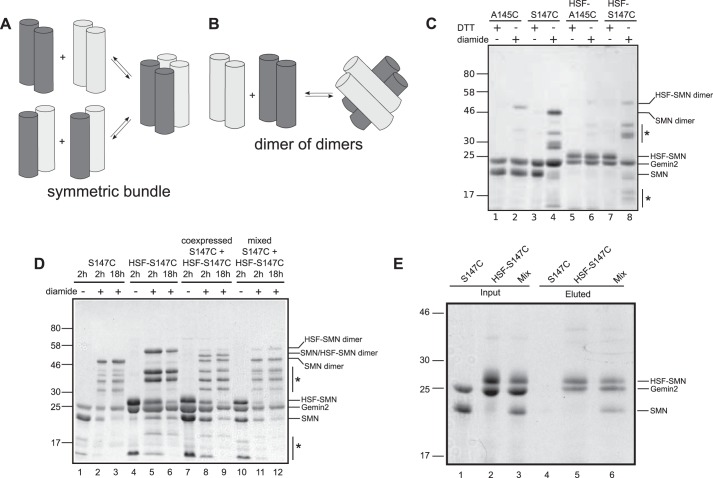FIGURE 10.
ySMN forms dimers of dimers. A, symmetric tetramer model of SMN. Dissociation of the tetramer results in formation of all possible pairings of helical dimers. Subunits are shaded to distinguish, for example, tagged from untagged subunits. B, dimer of dimers model of SMN. Subunits within dimers do not exchange when tetramers associate and dissociate. This model assumes that dimers are highly stable and do not exchange subunits on the time scale of minutes to hours. C, disulfide cross-linking of tagged and untagged SMN mutants. Ser147 is within the dimer interface, and the S147C mutant forms disulfide cross-links that can be identified as dimers on non-reducing SDS-PAGE. Ala145 is on the surface of the YG box dimer, and A145C is not efficiently cross-linked. HSF is a 28-residue His7-Strep-FLAG tag. All four cysteine mutants were prone to degradation during expression in E. coli, resulting in a weak background of truncated SMN subunits following purification (indicated by asterisks), which are also cross-linked to form SMN dimers for S147C constructs. D, untagged and tagged S147C ySMN·Gemin2 complex were incubated separately in the presence of oxidizing agent, resulting in formation of cross-linked SMN dimers (lanes 2 and 3) and HSF-SMN dimers (lanes 5 and 6) on non-reducing SDS-PAGE. When the two are co-expressed, a cross-linked HSF-SMN·SMN heterodimer is readily formed (lanes 8 and 9). When the two complexes are incubated together, no cross-linked heterodimer is observed (lanes 11 and 12). E, when tagged and untagged S147C SMN·Gemin2 complexes are incubated together and purified on Ni-NTA beads, untagged SMN is co-purified (lane 6), indicating the formation of mixed tetramers. The untagged complex alone does not bind efficiently to the nickel beads (lane 4).

